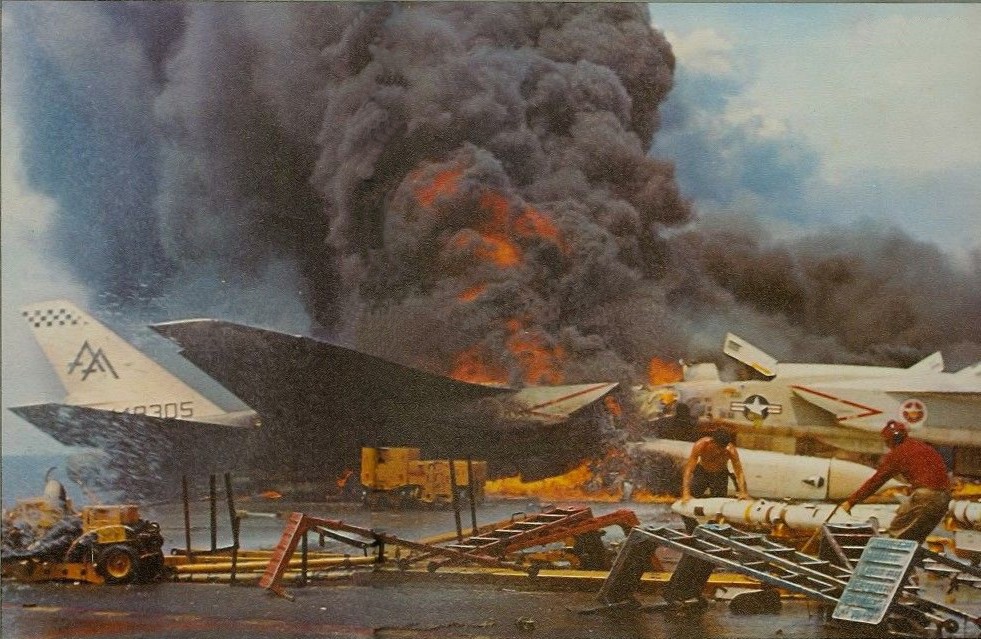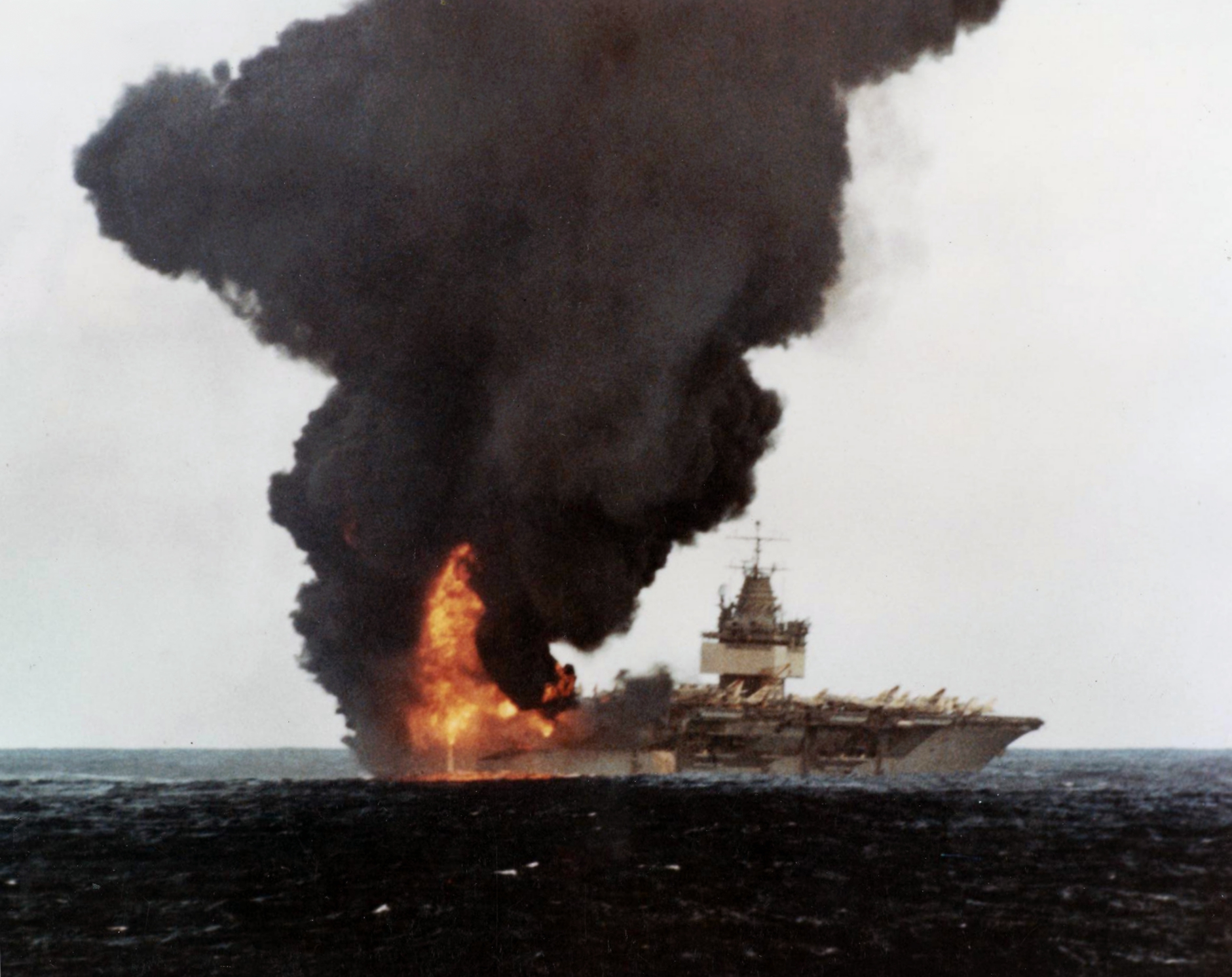You are using an out of date browser. It may not display this or other websites correctly.
You should upgrade or use an alternative browser.
You should upgrade or use an alternative browser.
Indian Military News, Reports, Data, etc.
- Thread starter bd popeye
- Start date
Any fire aboard a ship at sea, and particularly an aircraft carrier with all of its ordinances, fuels, etc. is a VERY serious matter...though I heard that this fire on the Viraat was relatively small and not too serious. That means they were able to contain it before it became that way.Reported from cjdby there was a small fire on Indian carrier Viraat.
Now...THESE are serious fires aboard carriers, which occurred during the Vietnam War aboard the the USS Forrestal (1967) and the USS Enterprise (1969):
USS FORRESTAL
GULF OF TONKIN
Killed: 134 --- Injured: 161 --- Lost Aircraft: 21



USS ENTERPRISE
OFF HAWAII
Killed: 27 --- Injured: 314 --- Lost Aircraft: 15
_fire_1969_explosions2.jpeg/1280px-USS_Enterprise_(CVAN-65)_fire_1969_explosions2.jpeg)


Both of these were accidents that occurred on decks full of armed aircraft and a lot of lives lost...and either could have sunk a US super carrier.
Both were caused by ZUNI rockets that cooked off.Expensive fires too. Was one of them caused by a misfired sidewinder?
The fire on Viraat was a small fire in the kitchen, no casulties reported.
On the Forrestal one inadvertently cooked off on an A-4 I believe, sitting on deck.
On the Enterprise a ZUNI rocket cooked off due to the exhaust heat from an engine starting unit.
When something like that cooks off into aircraft loaded with fuel and munitions...well, terrible things happen.
plawolf
Lieutenant General
Slightly off topic, but if think these fires underscore just how vulnerable carriers can be.
I know many people keep pointing to the sinking of USS America and the massive amount of damage the carrier managed to absorb without sinking as evidence of the invulnerability of carriers, but the important thing to remember is America was an empty hulk at the time of that test. Had she been carrying operational levels of fuel and munitions, the results would almost certainly have been much different.
If we look back at the history of famous warships that were lost in action during the last century, a massive percentage were killed by fire rather than sunk outright.
I know many people keep pointing to the sinking of USS America and the massive amount of damage the carrier managed to absorb without sinking as evidence of the invulnerability of carriers, but the important thing to remember is America was an empty hulk at the time of that test. Had she been carrying operational levels of fuel and munitions, the results would almost certainly have been much different.
If we look back at the history of famous warships that were lost in action during the last century, a massive percentage were killed by fire rather than sunk outright.
US Carriers are built specifically to take a lot of punishment, from missiles and torpedoes.Slightly off topic, but if think these fires underscore just how vulnerable carriers can be.
I know many people keep pointing to the sinking of USS America and the massive amount of damage the carrier managed to absorb without sinking as evidence of the invulnerability of carriers, but the important thing to remember is America was an empty hulk at the time of that test. Had she been carrying operational levels of fuel and munitions, the results would almost certainly have been much different.
But they are certainly not invulnerable as the US learned in World War II.
These incidents did not sink the super carriers, but they did a LOT of damage, and there were moments as large bombs began detonating where there was significant concern. However, none of these holed the carriers below the waterline either. Clearly, if enough bombs, or torpedoes, open up enough holes, then the carrier...or any other vessel is going down.
plawolf
Lieutenant General
US Carriers are built specifically to take a lot of punishment, from missiles and torpedoes.
But they are certainly not invulnerable as the US learned in World War II.
These incidents did not sink the super carriers, but they did a LOT of damage, and there were moments as large bombs began detonating where there was significant concern. However, none of these holed the carriers below the waterline either. Clearly, if enough bombs, or torpedoes, open up enough holes, then the carrier...or any other vessel is going down.
As I said, many of the famous warship kills in modern naval combat resulted from fires rather than the ships being sunk outright. Ships can be dead and still remain afloat for days or weeks after.
Those fires in your pictures effectively mission killed those carriers, and all of that came from tiny zommie rockets going off on the flight deck. A multi-ton AShM with hundreds of kilos of HE warhead going off inside the hull will do a lot of damage. As the America expriment showed, you need to get a little lucky with the hit to start a major fire, as the explosive force of the explosion will do comparatively littl to the carrier.
However, if the enemy mounts a sustained saturation attack to continue to hit the carrier with more AShMs after the first hit(s), that will massively complicate the fire fighting task, and the captain would likely order abandon ship even if the fire can be beaten as his ship and crew would just be effective target practice at that point.
The point is, a lucky pot shot that somehow got through the layed defence and struck a carrier is extremely unlikely to kill it, but a saturation attack that punched through the carrier's escorts and defences and one which continues to pound the carrier after the inital hit will almost certainly kill it even if you don't actually sink the carrier itself.
andyhugfan
Banned Idiot
I read somewhere in a book (don't bother asking, don't remember the title) that the Kh-22 AShM was specifically designed to target naval-carriers. The Russians estimated that they would need 12 conventionally armed Kh-22 to sink a carrier (nimitz class) or just one nuclear armed Kh-22.
Their doctrine was a mass attack with these missiles against CBG's and then make a run back. The Bears could also carry the missile, but it's relativly slow speed would make such an attack suicide for the crew....
Their doctrine was a mass attack with these missiles against CBG's and then make a run back. The Bears could also carry the missile, but it's relativly slow speed would make such an attack suicide for the crew....
This is exactly right.As I said, many of the famous warship kills in modern naval combat resulted from fires rather than the ships being sunk outright. Ships can be dead and still remain afloat for days or weeks after.
Those fires in your pictures effectively mission killed those carriers, and all of that came from tiny zommie rockets going off on the flight deck. A multi-ton AShM with hundreds of kilos of HE warhead going off inside the hull will do a lot of damage. As the America expriment showed, you need to get a little lucky with the hit to start a major fire, as the explosive force of the explosion will do comparatively littl to the carrier.
However, if the enemy mounts a sustained saturation attack to continue to hit the carrier with more AShMs after the first hit(s), that will massively complicate the fire fighting task, and the captain would likely order abandon ship even if the fire can be beaten as his ship and crew would just be effective target practice at that point.
The point is, a lucky pot shot that somehow got through the layed defence and struck a carrier is extremely unlikely to kill it, but a saturation attack that punched through the carrier's escorts and defences and one which continues to pound the carrier after the inital hit will almost certainly kill it even if you don't actually sink the carrier itself.
That is why the Soviet doctrine was to attack US Navy CSGs with REGIMENTS of Backfire and other bombers in an attempt to overwhelm the defenses and then pound the carrier. They were willing to lose a large percentage of those aircraft to get the job done...that is also why today a US carrier is normally escorted by at least three AEGIS vessels, and sometimes four.
Still, IMHO, the greatest threat to carriers remains submarines. A spread of 6-8 torpedoes, if they can get to the carrier, can accomplish the same, if not outright sink her. On the other hand, the nuclear carriers, if they have enough warning to get up "steam" (so to speak) are VERY fast. The actual top end, all out speed is classifed, but I have friends in the navy that tell me they can get up to and sustain 50 knots. Which would allow them (again if they had the time to get going) to simply outrun most torpedoes.
Which is also why in my fictional , I have the PRC develop a successful and operational, long range super cavitating weapon.
A FREE PDF download of the entire novel is available for SD members .
Last edited:
